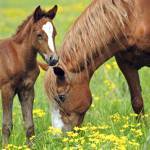Broodmare Care: Nutritional Support of the Recipient Mare

Successful embryo transfer typically requires optimal health of both donor and recipient mares, and this includes topnotch nutrition.
Once a donor mare is bred, either by natural cover or by artificial insemination with cooled or frozen semen, her uterus is flushed, and the embryo is collected 6-8 days after ovulation. The embryo is transferred into a recipient mare after it is evaluated for shape, size, and appearance. The recipient mare is then checked to verify pregnancy a week or so later.
Much rides on the health and well-being of a recipient mare. An ideal recipient mare should have a history of delivering live, healthy foals, have normal estrous cycles, and have no history of rejecting a foal. Most recipient mares are younger (between 4 and 12 years old), and many are chosen to be about the same size or larger than the donor mare.
Prior to transfer, a veterinarian must perform a thorough breeding soundness exam to determine if the recipient mare can adequately sustain a pregnancy. This includes ultrasound and uterine culture, biopsy, and cytology. The purpose of the ultrasound is to visualize the cervix, uterus, and ovaries. A mare with multiple uterine cysts, for example, is not considered a good candidate. The culture, cytology, biopsy results are used to determine the health of the uterine lining and presence of inflammation or infection.
Adequate body condition of the recipient mare is also important. “The ideal body condition for breeding is between 5 and 6, but a mare may hold a healthy pregnancy with a body condition score between 4 and 7,” said Kathleen Crandell, Ph.D., a nutritionist with Kentucky Equine Research.
Focusing on body condition, rather than ideal body weight, takes into account factors such as breed and conformation. “If a mare is too thin or losing weight, her hormonal balance may not be ideal for taking on the needs of embryonic implantation and maintenance of pregnancy,” explained Crandell. “If a mare is too fat, she risks embryo rejection because of chronic inflammation associated with obesity.”
Mares carry their foals for approximately 11 months. For the first eight months of pregnancy, a mare’s nutritional requirements will stay at about the same level as when the embryo was transferred. During the last three months, though, fetal growth accelerates, escalating the mare’s nutritional requirements quickly.
What if the recipient mare arrives at your farm pregnant and too thin? According to Crandell, “If a mare’s body weight is too low or high, it can take a couple of months to get it back to ideal, so patience is required. Working on weight gain is easier in the first trimester of pregnancy since the fetus is making minimal nutrient demands on the mare.”
For weight gain to occur, large amounts of calories are needed. “Where those calories come from is important. Aside from high-quality forage, mares will likely need a suitable concentrate,” Crandell explained. “Avoiding feeds high in nonstructural carbohydrates would be prudent. Opt for feeds with lower starch and higher fiber and fat for sound weight gain in the broodmare. These feeds will be less likely to provoke possible orthopedic or metabolic problems in the foal.”
For many mares, access to a high-quality, immature grass or alfalfa will meet most of their requirements throughout the year, but supplementation of protein, vitamins, and minerals is needed. A common way to meet these requirements is to use a ration balancer.
Starting in the third trimester and continuing through early lactation, a concentrate created specifically for broodmares can be added to the diet if needed to meet increased protein and energy requirements.
Targeted supplementation can be beneficial for broodmares. To support reproductive health, EO-3 is a popular choice. Studies performed by research groups indicate that long-chain omega-3 fatty acids, such as EPA and DHA, may improve fertility, colostrum quality, and passive transfer of antibodies between the recipient mare and her foal. Nano-E provides a natural, water-soluble source of vitamin E that has well-known antioxidant properties. Natural sources of vitamin E are preferred over synthetic ones as absorption is far greater.
The care and nutrition of recipient broodmares is just as important as any broodmare during gestation, throughout lactation, and after weaning.
This article was written by Ashley Abraham, a University of Florida alumnus and a former intern at Kentucky Equine Research. Learn more about internship opportunities at Kentucky Equine Research.








